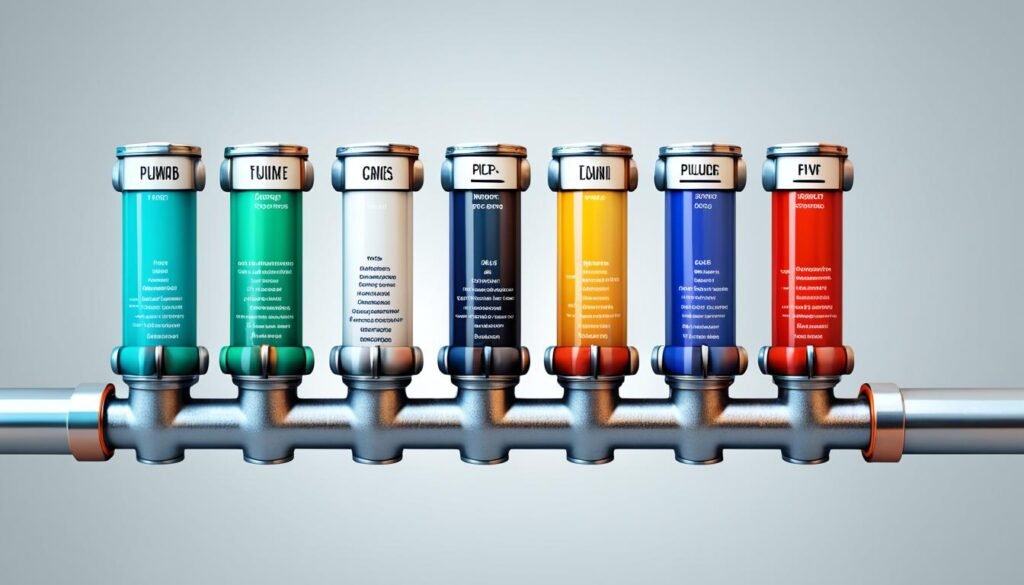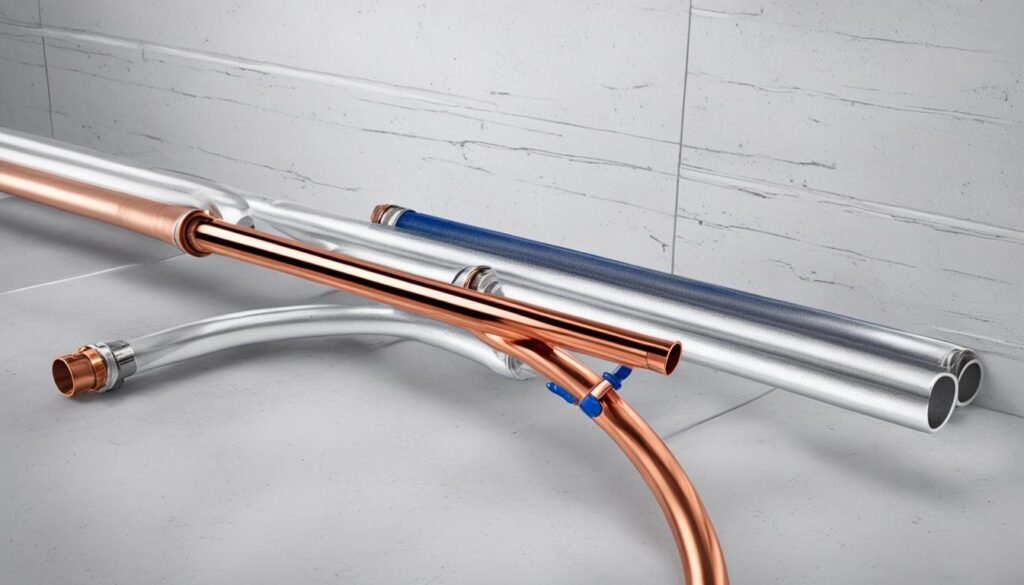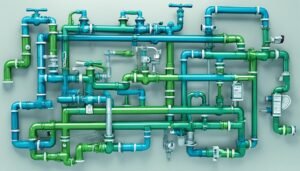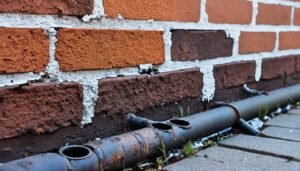
Did you know an average American home uses over 300 gallons of water daily? This fact shows how important plumbing pipes are in our lives. The pipes we choose can greatly affect how well the plumbing at home or in a building works. This article looks closely at the five main types of plumbing pipes. You’ll learn about their special features and where they’re best used. This will help you make a smart choice for your next plumbing job.
Key Takeaways
- Plumbing pipes come in a variety of materials, each with its own advantages and disadvantages.
- It’s important to pick the right pipes to ensure your plumbing system lasts long, works well, and is cost-effective.
- PVC, CPVC, copper, PEX, and cast iron are among the most common types of piping for homes and businesses.
- Knowing what makes each pipe material unique can guide you to the best choice for your situation.
- Getting advice from a professional plumber is also a good idea when choosing the right pipes.
Introduction to Plumbing Pipes
Plumbing pipes are the essential conduits that carry water, gas, and waste in your home. Choosing the right pipe can make your plumbing reliable and cost-effective. Different pipes have unique features for various needs.
The Importance of Proper Pipe Selection
Picking the right Main Types of Plumbing Pipes is key for your system’s performance, how long it will last, and the costs involved. You need to consider factors such as water pressure, temperature, and corrosion resistance when choosing.
For water supply, copper pipes are a good choice because they are tough and resist corrosion. Flexible PEX pipes are also a good option due to their easy installation and affordability. PVC and CPVC pipes work well for drainage because they last long and resist chemical damage.
Choosing the best pipes for your Dream Home Digest means your plumbing will operate well and cost less to maintain. It also ensures a steady water and waste system over many years.

“Proper pipe selection is the foundation of a well-functioning plumbing system that delivers consistent performance and longevity.”
Main Types of Plumbing Pipes
Choosing the right pipes for your plumbing is key to your home’s water system. You’ll find that copper pipes and PEX pipes are often used. They both have their own benefits, fit for various needs.
Copper Pipes
Copper pipes are known for lasting a long time and not rusting. They are great for hot and cold water. Copper is reliable over many years. It costs from $2.50 to $10 per foot, with a 75-year lifespan. For Type L ½-inch pipes, you’d spend around $3 per foot.
One good thing about copper pipes is they stay clean inside. They keep your water fresh. And since copper is good at moving heat, it’s perfect for hot water lines.
PEX Pipes
PEX pipes are known for being easy to work with. They can fit in tight spots. They resist scale build-up and chlorine, offering lasting quality. PEX pipes are also cheaper than copper, costing between $0.50 and $2 per foot.
PEX pipes can bend and twist easily. This makes installing them so much simpler. They don’t need as many connectors. Plus, they can span long distances without extra parts.

Deciding between copper and PEX depends on your plumbing needs. It’s wise to talk to a professional. Plumbers in Hemet CA can help you understand what’s best for your Dream Home Digest.
Rigid Plastic Pipes: PVC and CPVC
In the plumbing world, PVC and CPVC pipes are big players. PVC stands for polyvinyl chloride and CPVC means chlorinated polyvinyl chloride. They are both affordable and tough, perfect for things like water lines and drains.
PVC Pipes
PVC pipes are lightweight and don’t rust, perfect for cold water use and draining. They come in all sizes, from 1/2 inch to 4 inches wide. This makes them great for any size project, whether at home or in a business. Because they last a long time and can handle a lot of pressure, they’re often chosen by pros and homeowners.
CPVC Pipes
CPVC pipes are like PVC but can handle more heat. They work for both hot and cold water. Sizes range from 1/2 inch to 2 inches wide, fitting many needs. CPVC can take temperatures up to 200 degrees Fahrenheit. Even though they cost a bit more than PVC, they’re still cheaper than metal pipes.
Are you building something new or fixing up an old place? Knowing about PVC and CPVC pipes is key. Think about the cost, how durable they are, and if they can handle the temperature you need. This way, your plumbing will work great, and your home will be just how you want it.
Conclusion
Selecting the right plumbing pipe material is vital. It greatly affects how well your plumbing works, how long it lasts, and its cost. Knowing about the five main pipe types helps homeowners and contractors choose wisely. This ensures the plumbing runs well and is affordable.
For a new build or if you’re improving your plumbing, think about cost, how long it lasts, temperature, and how easy it is to put in. Topline Industries, a top plumbing pipe maker in India, is known for quality and delivery. They’re a great choice for your plumbing needs.
Talking to experts in places like Hemet, CA, is smart. They can help pick the best pipes. This improves how your plumbing works, how long it lasts, and saves you money. Selecting the right pipes is key for your home or remodeling project. It ensures your plumbing works well for a long time.
FAQ
What are the main types of plumbing pipes?
What are the key characteristics of copper pipes?
How do PEX pipes differ from other plumbing pipe materials?
What are the advantages of using PVC and CPVC pipes?
How can I ensure I choose the right plumbing pipe material for my needs?
Source Links
- https://www.neit.edu/blog/the-5-types-of-plumbing-pipes
- https://www.homedepot.com/c/ab/types-of-plumbing-pipes/9ba683603be9fa5395fab90cf2ccbfa
- https://www.thisoldhouse.com/plumbing/reviews/types-of-plumbing-pipes
- https://www.oatey.com/faqs-blog-videos-case-studies/blog/types-plumbing-pipes-residential-plumbing-systems
- https://www.forbes.com/home-improvement/plumbing/types-of-plumbing-pipes/
- https://www.apollopipes.com/blog/plumbing-pipes
- https://todayshomeowner.com/plumbing/piping/
- https://www.lenoxplumbing.com/the-5-main-types-of-pipes-used-in-homes/
- https://www.plumbwize.ca/blog/types-of-plumbing-pipes/
- https://trdsf.com/blogs/news/types-of-plumbing-pipes
- https://www.mrrooter.com/greater-syracuse/about-us/blog/2019/july/the-pros-and-cons-of-different-types-of-plumbing/
- https://www.1tomplumber.com/5-main-types-of-plumbing-pipes/
- https://toplineindustries.in/blog/types-plumbing-pipes-in-homes/
- https://prostarplumbing.ca/top-5-types-of-pipes-commonly-used-in-plumbing-their-uses-benefits/
- https://www.mrplumber.my/types-of-plumbing-pipes-and-their-uses/






No comment yet, add your voice below!